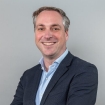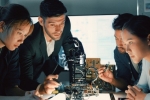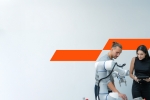
The Employment Group
The Employment Group (TEG) is an innovative platform of specialist companies in the staffing industry which focuses on connecting up professionals and clients in specific segments of the market. TEG – which facilitates these companies – was created in 2011, when it was just called Faber. Two years later, Tracé was added, a secondment agency for civil engineering professionals. In 2016 the Egeria investment company acquired TEG and two other companies, KP&T and Staatvast. Tracé and KP&T merged into Voort, market leader in the mediation of technical professionals in the Netherlands.
From five IT landscapes to a single platform
The merger created a company with five IT landscapes: Voort, Faber Painters, Faber Construction, Staatvast, and Koen. TEG’s CFO Monique Moos explains: “Egeria wanted to redefine the strategy. At the same time, our accountant advised us to work on our ICT strategy. We quickly realised ourselves that we wanted to move to a single digital platform that would allow genuine direct contact between clients and candidates.” Together with the team led by director Ron Martinek (PwC’s digital leader for private business), Monique Moos and her former colleague Léon Rust set to work on redefining the strategy. On 3 December, Jan-Willem Gelderblom took over from Léon Rust as CEO of TEG.

From left to right: Ron Martinek, Roos Bouman (both PwC), Jelle van der Zijden (director Voort), Monique Moos (CFO TEG) and Jan-Willem Gelderblom (CEO TEG).

Strategic considerations
At the start of the digital journey, TEG put together all ten applications that it had at the time. Representatives of the various labels could indicate what the ideal IT landscape would look like. “We actually wanted just a single application,” says Monique Moos, “but no integrated solution was available. We then discovered three applications that could be used by the whole group. Our basic principles were that it needed to be scalable, the processes had to run more efficiently, and it had to easy to add new apps. And above all, it shouldn’t take too long before we came up with something that we could bring onto the market.”
D.quarks
PwC’s d.quarks model provided guidance for determining the strategy. Ron Martinek explains: “First, we made sure that the technology and transactions were in order. We then tackled the customer experience aspect, and starting from there we began thinking about solutions, so as to eventually achieve open digital status. You can view it as a platform on which other parties can plug in with an API. Quarks are elementary particles, and we see the d.quarks as particle accelerators in digital transformations. Companies often say that they ‘need something with artificial intelligence or blockchain’, but then you allow the ‘T’ of ‘technology’ to dominate. Our BXT approach brings together Business, eXperience, and Technology. We’ve never really talked about technology at TEG. It was a given that was available.”
From state-of-the-art enabler to innovating game changer
TEG was mainly looking for a platform as a state-of-the-art enabler of the operational process, to which all operating companies could connect. It would then take it to market as an innovative game changer. “We want to be a frontrunner in the digital field,” says Monique Moos. “It needs to be clear to candidates and clients that our labels are genuinely different. In the case of professionals, that means the day-to-day payment of wages or a digital loyalty programme or an hours app. Later, we also want to be able to expand our platform to other sectors or to other countries. Or market it to other companies in the sector, or relieve SMEs of their administrative burden. We’ve said that for now we aim to set up a beautiful Christmas tree and decorate it. But if we decide later that the decorations need to be different, then it needs to be easy to change them. So it’s about ‘plug and play’ – who doesn’t want that? But you’ve first got to get it done!
“Can do” mentality
PwC’s Ron Martinek, Roos Bouman and Daniel van Norren, who are guiding the process at TEG, praise the company’s “can do” mentality. Ron Martinek explains: “It’s rare to see a process that goes so fast. The problem with big companies is often that they’re like an oil tanker that doesn’t have enough speedboats around it to make sure that it keeps going in the right direction. As a relatively young company without much in the way of ‘legacy’, TEG can operate like a speedboat. Other middle segment companies could do the same but they don’t. That’s because they’re afraid of one of those tankers or of high waves. That’s not been a problem at TEG. Indeed, I remember a meeting of the Supervisory Board where they asked us ‘So what’s it going to look like?’ We gave them an honest answer: the ‘what’ and the ‘why’ are clear, but we don’t yet know what the ‘how’ will look like. What we do have, however, is an approach which you can be confident we arrive at a solution.”
“It’s typical of our culture that we’ve dared to take that step,” says Monique Moos. “Our ‘why’ was clear from the start: we want to be the number one mediator for job satisfaction. Making the right match as regards a job, but also ensuring a good work/life balance. Achieving the ‘how’ has only increased confidence. We brought together all the label leaders within TEG and explained our top-down vision. But the final choices we needed to make were genuinely made from the bottom up. The decision-making process took five months and the implementation four.”
Jelle van der Zijden, director of Voort, enthusiastically adds: “The confidence in where we wanted to go was so great that we thought: ‘if we could achieve that...’. I sometimes talk to directors of other firms, and they tell me: ‘we’ve got a plate of spaghetti on the table, but we don’t know which strand to pull first in order to bring about change’. We dared to empty out the whole plate and start all over again, with support in the right echelons of the organisation.”

"I remember a meeting of the Supervisory Board where they asked us ‘So what’s it going to look like?’ We gave them an honest answer: the ‘what’ and the ‘why’ are clear, but we don’t yet know what the ‘how’ will look like. What we do have, however, is an approach which you can be confident we arrive at a solution."

Experience Center Frankfurt
TEG had the opportunity, necessity, scale, and also mentality to bring about the digital transformation. A two-day trip with all the stakeholders to PwC’s Experience Center in Frankfurt also helped maintain the energy level for a long time. “Frankfurt showed us how to innovate,” says Monique Moos, “and that it really helps to think “outside the box” in a different setting so as to arrive at a new vision. If we’d just done that at the office, we’d just be back on the beaten track. As it was, we gave ourselves the space to literally be completely out of it and to be inspired by what’s going on in the market. That enabled us to broaden our vision. We talked various external speakers and start-ups and joined together to determine what our approach would actually look like. That resulted in a prototype that we validated within two days. Once we were back home, we could provide an example, in Voort’s new house style, of what the tool might look like.”
Boest
The minimum viable product (MVP) that was created after the visit to the Experience Center was given the name “Boest”. Monique Moos explains: “Boest originated as an internship platform, based on the idea that if you get trainees committed to your organisation you enable them to advance within it as employees. If we achieved that, we thought, we could make some kind of end-product for the internship market and then roll it out to young professionals and the whole organisation. When we clarified its impact to the Supervisory Board, they immediately said: “Skip the internship market, we’ll start right away with Voort. We can do the internship market later.’ So Boest immediately became part of the existing business. On 29 October 2018, Boest went live at the pilot location in Apeldoorn.”
“Users’ initial experience is good, says Jelle van der Zijden. “Clients are deciding to place candidates based on our career test in Boest. The response of candidates who come to the intake is “Wow, this really is different to at the other firms.’ In MVP 1 we mainly looked at the candidate. In the next phase, moving on towards MVP 2, we’ll be looking more at the match with the client. That’s when I think the magic will really kick in. Then we’ll really made an impact on the market.”

"In the next phase we’ll be looking more at the match with the client. That’s when I think the magic will really kick in."

"In 2020, we need to be able to use scalability as a basis for performing analyses to influence the predictability of the candidate’s success vis-à-vis the client, or the candidate’s own job satisfaction."
Predictability of success
What TEG wants most is a situation in which candidates and clients in the technical field are unable to avoid Boest as an app. Monique Moos: ‘‘I’ll be happy if the system is up and running by the end of 2019 and doing what it should do, and everyone is working with it. And that we then top that in 2020...”
“... and really turn Dutch employment mediation upside-down,” adds Jelle van der Zijden. “Just imagine: you’ve got a laptop with candidates and vacancies listed. And you only need a single click to create a match between a candidate and various vacancies. In other words, a self-learning algorithm can make a better match than you could initially do yourself. If that becomes possible, then I’m convinced that more doors will open than we can even imagine right now.”
Jan-Willem Gelderblom concludes: “If the system works in 2019 and the matches between company and candidate are correct, then we’ll be satisfied and we’ll look at scalability. In 2020, we need to be able to use that scalability as a basis for performing analyses to influence the predictability of the candidate’s success vis-à-vis the client, or the candidate’s own job satisfaction. Just imagine: you’ve got a candidate who’s a rather chaotic person but who has a lot of experience in the field of work preparation. If the company knows that in advance, then it can place someone alongside him or her who can provide structure. That means you’ve then got two people who can perform very well within your company. That benefits both business operations and the work satisfaction of those employees. If we can manage to do that, then we’ll really be the number one mediator for job satisfaction.”
Contact

Ron Martinek
Partner, Microsoft Alliance Lead Netherlands, PwC Netherlands
Tel: +31 (0)62 243 92 72















